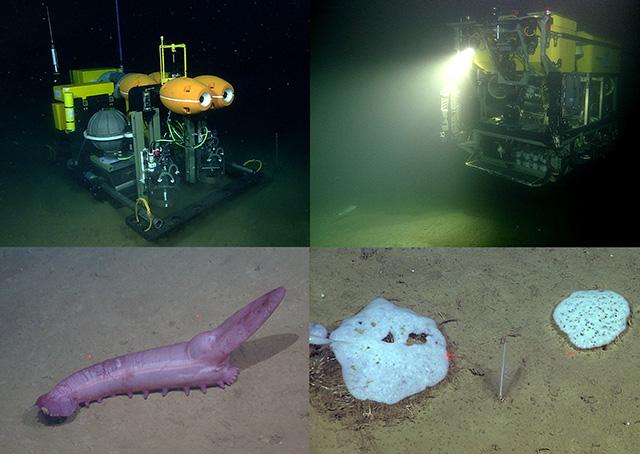
Credit: Images © MBARI
MOSS LANDING, CA–For 30 years, MBARI ecologist Ken Smith and his colleagues have studied deep-sea communities at a research site called Station M, located 4,000 meters (2.5 miles) below the ocean’s surface and 290 kilometers (180 miles) off the coast of Central California. A recent special issue of the journal Deep-Sea Research features 16 new papers about research at Station M by scientists from around the world. These papers cover a wide range of topics, from satellite observations of the sea surface to the behavior and genetics of deep-sea life.
The deep seafloor is one of the largest and least known habitats on this planet. The flat, muddy expanses of the deep ocean floor–known as the abyssal plain–cover more than 50 percent of Earth’s surface and play a critical role in the Earth’s carbon cycle. Scientists visit from time to time, but they rarely get to stay long. That’s one reason why the long-term studies at Station M are so remarkable.
Animals on the deep seafloor get most of their food from the sunlit surface waters thousands of meters above. This food typically arrives in the form of marine snow–bits and pieces of dead algae or animals that sink to the muddy ocean bottom. This detritus carries carbon from the surface waters to the deep sea.
Because much of this carbon originates as carbon dioxide in the atmosphere, sinking marine snow indirectly reduces the amount of carbon dioxide in the atmosphere and sequesters organic carbon in the deep ocean over geologic timescales.
Station M is the only deep-sea site in the world where scientists have conducted long-term, continuous measurements of both the supply of carbon to the seafloor and the consumption of this organic carbon by deep-sea animals and microbes.
Over the past three decades, Smith and his colleagues have developed and used a whole suite of oceanographic tools to study Station M. These include satellites, research ships, bottom trawls, human-occupied vehicles such as Alvin, remotely operated vehicles (ROVs), a robotic seafloor rover, seafloor landers, coring devices, fish traps, sediment traps, respirometers (which measure oxygen consumption), current meters, and time-lapse cameras.
The underwater observatory at Station M includes instruments and robots that operate autonomously 24 hours a day, seven days a week. MBARI scientists only need to visit the site once a year to collect and download data, service instruments, and swap out batteries.
The results of this research have dramatically changed marine biologists’ perceptions of life in the deep sea. For one thing, the data show that the deep seafloor is far from static–physical conditions and biological communities can change dramatically over time scales ranging from days to decades.
Research at Station M also confirmed that changes on the seafloor directly relate to conditions near the sea surface. For example, huge populations of algae or gelatinous animals such as salps may consume available nutrients and food in surface waters, then die and sink rapidly to the bottom. The resulting “blizzard” of detritus provides a feast for deep-seafloor organisms, allowing some species to reproduce and dominate seafloor communities–at least until most of the food is used up.
Such “feast and famine” cycles affect some seafloor animals more than others. For example, some species of sea cucumbers were rare at Station M in the 1990s, then became extremely abundant, and then disappeared entirely. Other sea cucumbers had relatively stable populations throughout the 30-year study.
The 16 research papers in the special edition of Deep-Sea Research cover these topics and many more. Two of the papers focus on connections between processes at the sea surface and the amount of carbon reaching the deep seafloor. Three papers examine the types and amounts of material sinking down through the water. Two other papers describe changes in the chemical and biological conditions on the seafloor. The remaining nine papers describe animals and microbes living on and near the seafloor and how these organisms respond to changes in their environment.
The papers in this volume provide an overview of ongoing research at Station M and show how this research has improved scientists’ understanding of the biogeochemistry, biology, and ecosystems on the deep seafloor. As human impacts in the ocean become more pervasive, research at Station M and at similar sites around the world are essential to understanding this vast but little-studied environment. Long-term studies such as the Station M time series are also essential for understanding long-term changes in the ocean and in Earth’s climate.
Smith and his research team hope to continue their work at Station M to find out if the surprising changes in seafloor communities will continue. They will also be developing new technologies that will allow researchers to monitor conditions at Station M from shore in real time.
###
Link to online news release with images: https:/
Link to special issue of Deep-Sea Research: https:/
Media Contact
Kim Fulton-Bennett
[email protected]
Original Source
https:/




